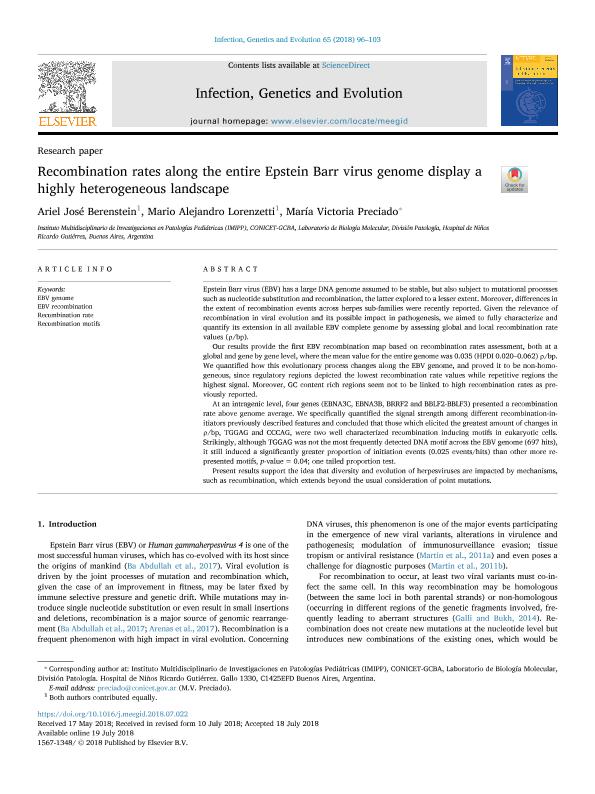Artículo
Recombination rates along the entire Epstein Barr virus genome display a highly heterogeneous landscape
Fecha de publicación:
07/2018
Editorial:
Elsevier Science
Revista:
Infection, Genetics and Evolution
ISSN:
1567-1348
Idioma:
Inglés
Tipo de recurso:
Artículo publicado
Clasificación temática:
Resumen
Epstein Barr virus (EBV) has a large DNA genome assumed to be stable, but also subject to mutational processes such as nucleotide substitution and recombination, the latter explored to a lesser extent. Moreover, differences in the extent of recombination events across herpes sub-families were recently reported. Given the relevance of recombination in viral evolution and its possible impact in pathogenesis, we aimed to fully characterize and quantify its extension in all available EBV complete genome by assessing global and local recombination rate values (⍴/bp).Our results provide the first EBV recombination map based on recombination rates assessment, both at a global and gene by gene level, where the mean value for the entire genome was 0.035 (HPDI 0.020-0.062) ⍴/bp. We quantified how this evolutionary process changes along the EBV genome, and proved it to be non-homogeneous, since regulatory regions depicted the lowest recombination rate values while repetitive regions the highest signal. Moreover, GC content rich regions seem not to be linked to high recombination rates as previously reported.At an intragenic level, four genes (EBNA3C, EBNA3B, BRRF2 and BBLF2-BBLF3) presented a recombination rate above genome average. We specifically quantified the signal strength among different recombination-initiators previously described features and concluded that those which elicited the greatest amount of changes in ⍴/bp, TGGAG and CCCAG, were two well characterized recombination inducing motifs in eukaryotic cells. Strikingly, although TGGAG was not the most frequently detected DNA motif across the EBV genome (697 hits), it still induced a significantly greater proportion of initiation events (0.025 events/hits) than other more represented motifs, p-value = 0.04; one tailed proportion test.Present results support the idea that diversity and evolution of herpesviruses are impacted by mechanisms, such as recombination, which extends beyond the usual consideration of point mutations.
Palabras clave:
EPSTEIN BARR VIRUS
,
RECOMBINATION RATE
Archivos asociados
Licencia
Identificadores
Colecciones
Articulos(IMIPP)
Articulos de INSTITUTO MULTIDISCIPLINARIO DE INVESTIGACIONES EN PATOLOGIAS PEDIATRICAS
Articulos de INSTITUTO MULTIDISCIPLINARIO DE INVESTIGACIONES EN PATOLOGIAS PEDIATRICAS
Citación
Berenstein, Ariel José; Lorenzetti, Mario Alejandro; Preciado, María Victoria; Recombination rates along the entire Epstein Barr virus genome display a highly heterogeneous landscape; Elsevier Science; Infection, Genetics and Evolution; 7-2018; 96-103
Compartir
Altmétricas




